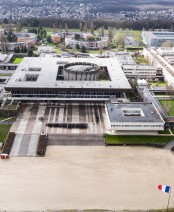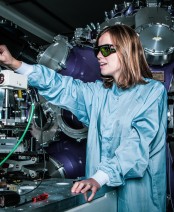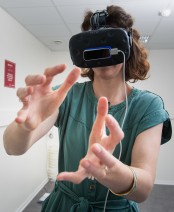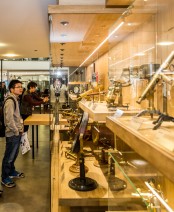Pascal Chabert awarded a CNRS silver medal

Plasmas are the field of expertise of Pascal Chabert. They are made of matter in which electrons are torn from the atoms with which they are usually associated in neutral gases. This is known as an ionised medium. The CNRS research director is particularly interested in 'cold', low-temperature plasmas, created by an electrical discharge in a gas. "Their temperature is low enough not to melt the materials with which they are in contact. However, these low-temperature plasmas are reactive enough to modify polymers, metals and especially semiconductors... as if their temperature were very high. They therefore have many industrial applications," explains Pascal Chabert.
Plasmas for microelectronics
As much as the subject, people he met led him down this path. Among them, Jean-Paul Booth convinced him to do research. Then Jérôme Perrin, whom he found inspiring became his thesis director, carried out in partnership with Thomson-CSF (now Thalès). Finally, Michaël Lieberman, a leading scientist in the field of low-temperature plasmas, whose laboratory he visited in Berkeley, California. It was there that he left on a post-doctoral fellowship to pursue more fundamental work, but in line with his thesis, with applications on plasma etching processes. Etching for microelectronics is the most important application of low-temperature plasmas: it enables the nanometric-scale machining of semiconductors in order to manufacture, among other things, computer transistors.
"Working on industrial devices is one of the hallmarks of my career," says Pascal Chabert. Paradoxically, it is also in these areas that very fundamental research can be carried out. Indeed, a small increase in industrial performance, which is profitable given the investments in the field, is often based on important fundamental results. For example, his work on the electromagnetic effects in so-called 'radio frequency' plasmas has made it possible to improve the uniformity of etching processes on large surfaces. Pascal Chabert was joined the CNRS in 2000 when the Plasma Physics and Technology Laboratory was founded, which later became the Plasma Physics Laboratory (LPP*), which he directed from 2015 to 2019.
This early career research led him to synthesise the knowledge of the field with his British colleague Nicholas Braithwaite in the book 'Physics of Radiofrequency Plasmas' for students, researchers and engineers working in the vast field of plasma processes for microelectronics. "But beyond applications, fundamental research is primarily concerned with mechanisms," continues Pascal Chabert. And it is striking to see that an idea we have had can be applied in a completely different field."
New propulsion concepts
In this case: space propulsion, which Pascal Chabert discovered in 2005 when the European Space Agency (ESA) asked him for his opinion on a plasma propulsion engine project. Like chemical rocket engines, plasma thrusters are based on Newton's third law: a force created by the expulsion of a particle in one direction generates a thrust in the opposite direction. But rather than burning fuel, the idea is to accelerate particles in a plasma. These plasma engines are widely used for satellite orbit corrections, or during interplanetary probe journeys. He discovered a fascinating world and realised that concepts from microelectronics could be applied to it, for example by jointly accelerating positive and negative ions in order to avoid as far as possible deleterious effects linked to electrons. The researcher thus proposes a thruster concept called PEGASES (Plasma propulsion with Electronegative GASES).
"It turns out that this concept doesn't work as well as we thought. But the fact that things don't work as planned is very important in research. A good scientist has to try and make mistakes in order to move forward." The project was not in vain, as it led, among other things, to the identification of iodine as the ideal gas from which to create the plasma for the propulsion (instead of the xenon). Ane Aanesland, who came to do a post-doctorate with Pascal Chabert, founded the start-up ThrustMe in 2017, which commercialises iodine propulsion systems to motorise small satellites.
Pascal Chabert continues to work on new propulsion concepts, but also within the framework of an industrial ANR chair led by Anne Bourdon with Safran on simulation and design tools for "Hall effect" plasma thrusters that the manufacturer is developing. If he is so passionate about the field of space, it is also because he can see the motivation and the appeal that this subject has for students. "They are the ones who came to meet me so that I could get involved in the Student Space Center of Ecole polytechnique" he says. Their latest flagship project: the planned launch in 2024 of the IonSat nanosatellite equipped with an engine from the start-up ThrustMe.
*LPP: a joint research unit CNRS, École Polytechnique - Institut Polytechnique de Paris, Observatoire de Paris, Sorbonne Université, Université Paris-Saclay








